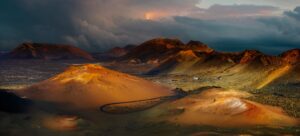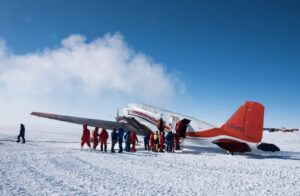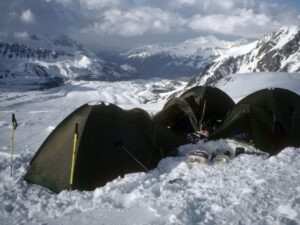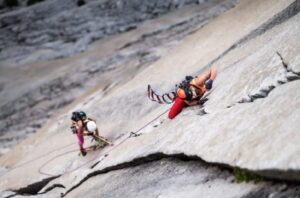Before setting off, Oscar Scafidi and Ben Ziehm Stephen had studied the two major tributaries of the Mangoky River in Madagascar, trying to decide which to follow.
The Mananantanana, as well as having far too many ‘a’s and ‘n’s, had the furthest source from the river’s endpoint. But the Matsiatra fed in more water. In the end, they spent time following both, schlepping their gear around rapids, over mountains, and into jungles.
They began with a much simpler plan: Find the source of the Matsiatra and follow it. Portaging where necessary, they would stick with it to the confluence with the Mangoky. From there it would be a relatively easy cruise down this wider, more sedate river to the sea.
But the plan went awry from the start. Just finding the Matsiatra’s source proved difficult. They carried only an old hydrologist’s report that detailed the source’s location relative to a local mountain, not with GPS coordinates. Soon, Scafidi and Stephen sought out local advice.

Sunset on the river in rural Madagascar. Photo: Oscar Scafidi
Hiking, hiking, and more hiking
On May 6, they journeyed from the capital, Antananarivo, down to the town of Fianarantsoa. From there they took a 4×4 as far as it could go into the mountains.
When the 4×4 waved the white flag, they hopped onto a Kamaz truck that the locals used as a makeshift bus service. When rutted mud roads stopped further progress, they started hiking. They eventually camped in a small village with a local guide they had managed to secure.
Now close to the source, the next day should have been easier. Instead, they ended up hiking for another 21km. The local guide knew only roughly where the source was. He eventually decided the search was not worth it.
Scafidi and Stephen then cycled through three sets of new guides from local villages, who also proceeded to abandon them as soon as they realized that they needed to find the actual source of the river, not just get vaguely near it.
Their search was looking increasingly desperate when they finally lucked out. Completely by chance, they bumped into a kindly man who said that he lived in the very last settlement on the river. He tagged along with them, let them stay a night in his house, and then showed them the source the next morning. It was a hard slog.
“By the end, we were averaging about 600m per hour in the jungle,” Scafidi told me shortly after finishing.

The final village before the source of the Matsiatra. Photo: Oscar Scafidi
A little paddling, then still more hiking
It took another seven kilometres of hiking to find a spot to launch their folding Klepper sea kayak. Finally on the river, they paddled 16km before setting up their first campsite of the expedition. The next day they smashed out 45km, seemingly turning the corner after some painfully slow days.
But the river soon showed its teeth. The Klepper shines as a large-capacity sea kayak but is not built for white water. A succession of rapids and waterfalls forced them off the river. The original plan was to portage about 50km and then get back in the Matsiatra.
“But on the ground, we realized this was going to be completely impractical…We had to completely rejig to avoid a large section of Matsiatra,” Scafidi explained. It was the start of what would prove to be a very long portage.

The pair portaged for nearly 200km. Photo: Oscar Scafidi
Illness strikes
They disassembled the kayak and carried it nearly 100km over three days to the town Ikalamavony. From there, they headed west and then southwest through the mountains with a new guide.
The hike was “extremely difficult and very unpleasant,” trying to follow the Matsiatra as best they could while shouldering over 20kg of gear each. They concluded that it would be easier to drop down further south to the other tributary, the Mananantanana, which looked easier to hike and perhaps even kayakable.
“It was a slightly foolish mistake,” said Scafidi, “but we were desperate to stop carrying this kayak and start paddling it. The minute we hit a section that was wide and fast-flowing, we hopped in. The locals reassured us that it was fine with no waterfalls, but their definition of fine was a little different from ours! It ended up being two of the most difficult days of the entire trip.”
About 10km from the village, they hit rapids. Over the next four days they spent a lot of time in waist-deep water leading the kayak through the fast-moving water or moving it in and out of the river.
To make matters worse, Stephen had begun to feel very ill. Nauseous and extremely tired, they believe he contracted bilharzia. Bilharzia is an infection caused by parasitic worms and is potentially very dangerous. Fortunately, symptoms tend to be short-lived, though they often recur. Stephen battled through and felt better after a couple of days.

A riverside campsite and their Klepper. Photo: Oscar Scafidi
The Mangoky at last
Three more days of portaging took their grand total for the expedition close to 200km before finally, they arrived on the banks of the Mangoky River on May 20. The Mangoky played to the Klepper’s strengths, and they whipped along the river, covering over 40km per day.
But it wasn’t all smooth sailing. This time, a mystery illness hit Scafidi. They worried it could be malaria, but after three miserable days, Scafidi’s health improved.
“We were very lucky that both our illnesses resolved themselves and allowed us to finish,” Scafidi said.
The mouth of the Mangoky opens into a huge delta. Here their local logistics man, Max, met them to escort them out to the open sea.
“We were a little worried about crocodiles and bull sharks in the delta, but Max was more concerned about how the local population would react to us. This seemed strange when we’d had nothing but positive experiences for the entire trip, but apparently, there were local rumors about foreigners harvesting people’s organs, stealing their eyes and things…”
They paddled out into the Mozambique Channel to finish, capping off a 24-day, over 700km journey. With their unusual route and so much portaging, it will be interesting to see if Guinness rubber-stamps their “fastest time to travel the Mangoky River by kayak/canoe in a team.”

Scafidi (left) and Stephen. Photo: Oscar Scafidi






